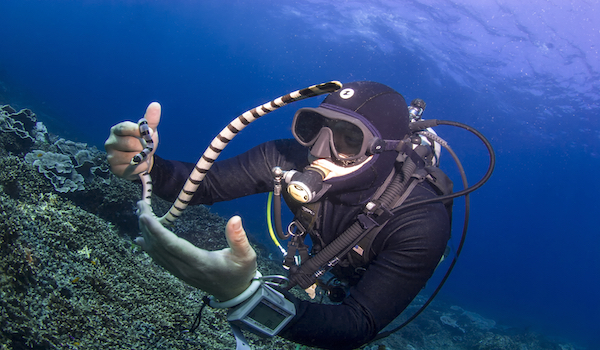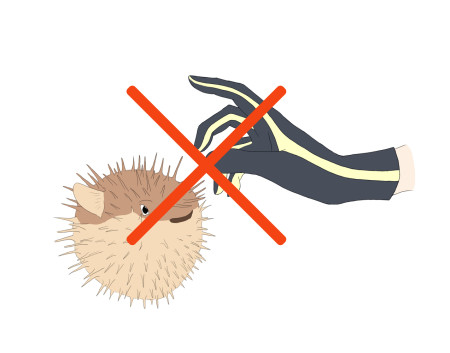Here is Why You Should Never Touch Marine Life
Did you ever touch marine life while diving?
Be honest…
We are sensuous creatures, we rely on our senses, most animals do after all. Sight, sound, touch, taste, smell. We garner information about our surroundings this way. We are also a tactile species.

Don’t become that diver, just don’t
Our hands have evolved to manipulate objects; opposing thumbs distinguish us from our nearest living relatives. In short, we touch and change our world almost instinctively, just look at a baby and how it grabs things.
So when someone says “Don’t touch marine life” it does go somewhat against our inbuilt desire to do the opposite. That person be it your Mother, Father or Divemaster or Mother-of-all-Divemasters, who does utter those words, is not however doing it just to hear their own voice.
Here’s why you should never touch marine life
Both animals and plants underwater possess many defense mechanisms, they have to otherwise they would be something else’s dinner. That is why you should not touch marine life.

Spines whether they are concealed or apparent are everywhere and in more places than you’d realize. Sea Urchins are obvious, but many fish have them too. Most spines are found on a fish’s fins, they form the structural strength a bit like fingers allowing the fish to move them around and erect them when necessary. They are sharp, hard, and the fish will use them to defend itself.
Those like the Triggerfish have a modified dorsal fin that is locked upright to make it vastly harder for large predatory fish to swallow them.
Another defense mechanism that I have to admit I’ve fallen foul of, are found in the Surgeonfish family. Where the tail fin meets the Surgeonfish fish’s body, a part called the Caudal Peduncle, a set of VERY sharp, blade-like appendages is found.
While the fish with these added blades doesn’t wield them about like a Samurai, they are certainly enough to damage the mouth parts of many a predator trying to eat them. If the prey fish can inflict some pain on the predator causing them to let go, then those blades have served their purpose.
If sharp spines and razor blade appendages aren’t enough, many are also loaded with poisonous chemicals. Lionfish are one of the most obvious examples, but there are other much more insidious fish out there.
Also read: Lionfish:10 facts you need to know about juvenile eating invasive predator
Poisonous Master of disguise
Stonefish and Scorpionfish are two examples where the animal utilizes camouflage to hide, and poison loaded fin spines to inflict sometimes fatal injuries on anything attempting to eat them. We can fall foul of this by not looking where we are going or touching anything without looking.
Extensive tissue death can occur from the powerful toxins these fish carry, those that have carelessly been stung experience incredible pain also with wounds taking months and even years to heal.
A huge number of soft and hard corals also possess mechanisms designed to inflict damage upon anything that touches them. Jellyfish to carry within particular parts of their bodies structures called nematocysts that inject tiny syringes of the toxin into anything that activates them by touch. Fire Corals get their name from this very painful defense mechanism.
So you see there are many ways that marine creatures defend themselves, passive adaptations that stop things from taking a bite.
(Article continues below)
Feel free to check out our Scuba Dive partners anywhere in the world for packages, training or guided trips:
Active defense mechanisms
Speaking of bites though, we haven’t even discussed the active defense mechanisms yet. Apart from just swimming away which is by far the most preferred defense for many fish, if an aggressor is persistent animals may have to resort to direct reciprocal aggression themselves, namely biting.
“If you put your hand in a crack and you don’t get it back, that’s a Moray”, so the song goes.
Well it’s true if you go rooting around in a Moray’s hole and it doesn’t have anywhere to flee to, you find out what it’s like to have all those needle sharp, backwards pointing teeth sink into your hand. I would imagine it’s excruciatingly painful, not to mention the total lack of sympathy you would get from me.
Contrary to what Hollywood and certain sensationalist TV shows would have us believe, animals are not inherently aggressive. They don’t swim around looking for the next diver or swimmer to bite. If an animal does bite, it’s because it has either mistaken you for food or it’s a last resort defense after severe provocation. It risks being hurt in the process so if there is another way to get away it would rather do that.
Other reasons why you shouldn’t touch animals underwater
Things like corals and fish have a layer of mucous covering them which is anti-bacterial. It keeps out or kills parasites, helps fight infection and keeps them healthy, so when someone comes along and strokes the Napoleon, or cuddles the Grouper it removes much of the protective coating.
This causes problems in the long run. In one particular case, I have seen Groupers become infested with lice once they became tame and were being handled by scuba divers time and time again each day. The animals started to look quite sick with open wounds and lice all around their eyes and mouth.
Repetitive petting is also commonly associated with feeding. Quite often small scraps of food are offered to get the animal close enough to pet, and this disrupts the natural feeding behaviors.
Also read: Not So Obvious Dangerous Marine Animals
This can have other disastrous effects where the animals become so used to being fed they expect it, and injuries to divers can occur when the animal bites. Feeding frankfurters to a Napoleon may seem innocent but to a Napoleon fingers also look like Franks and mistakes are made.
And finally onto my ultimate point. you may be reading this and think, “All of this doesn’t matter to me because I wear gloves. After all, that’s why we wear gloves isn’t it, to remove the risk of hurting ourselves?” Well, all I can say is, with that attitude you are more likely to touch marine life and cause damage to the reef and it’s inhabitants.
Far too many times I have seen qualified divers compensating for their lack of buoyancy control by using their gloved hands to push off things, grab hold of things to pull themselves along or just man-handling reef creatures. This is not the right way to do things. This is the wrong philosophy. It should be discouraged everywhere possible as it breeds the wrong diving mentality.
Wreck diving maybe, commercial diving certainly but for your every day recreational diver in warm water gloves are not necessary.
Now my last point. Why you should not touch marine animals
Imagine if you were a reef inhabitant and some alien comes along and starts trying to grab you, plucks you out of your home or safe territory on the reef then sticks you back or worse yet just drops you? Where do you end up?
Have you been fatally wounded in that process? Will you be able to find your way back to your shelter before you are eaten? Have you had your home destroyed? Have you been so stressed by their groping and grabbing you flee away from your security?
So maybe the Golden rule of diving might be “Never hold your breath” , if you consider and care about the animals you are there to see, it could also be “Do unto others as you would have them do unto you”.
We have multiple partners that offer Scuba Dive packages including accommodation, training and guided trips. Feel free to check out our listings:
What are your thoughts about touching marine life? Let us know in the comments below
This article is written by Rutger and published by The Scuba Page, the online magazine for Scuba Dive lovers around the world. The Scuba Page is part of RUSHKULT: the online booking platform for adventure sports. Visit the RUSHKULT platform to book your next Scuba Dive training, guided trip and accommodation.

Leave a Comment